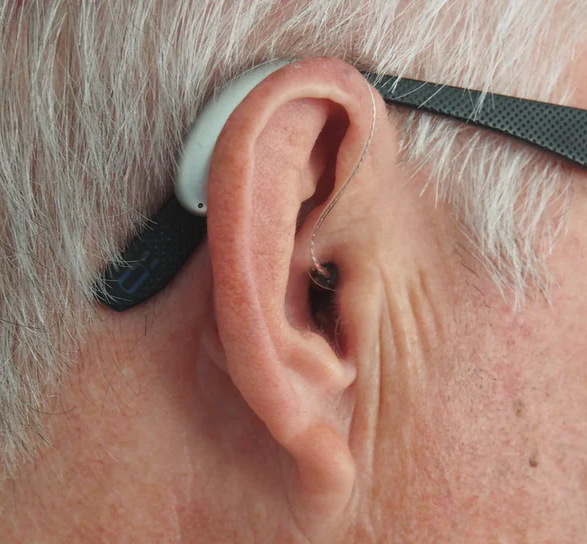
I purchased hearing aids in early November, six months after a hearing test confirmed that I needed them. I spent those six months acting as an engaged patient/consumer: shopping, comparing, questioning, hoop-jumping, becoming discouraged, renewing my resolve and, at last, following through with a purchase. I‘m going to describe my experience in some detail, hoping that others who find the process daunting might benefit from what I have learned and be encouraged to stick with an often frustrating, time-consuming and expensive process.
Before describing that bumpy road, I want first to say that I’m happy with the result. My hearing aids work well most of the time and have become my “new normal.” I wear them when I’m alone. The strongest confirmation has come when I’ve appreciated their value after the fact. There have been times when I didn’t have to work hard to understand people, for example, at a lively garden party or to easily talk with my neighbor at quite a distance outdoors. The best news is that in both cases I took my ability to hear and comprehend for granted in the moment, aware of the improvement only on later reflection.
For my hearing test, I visited a suburban outpost of a highly esteemed Boston hospital. The test was covered by my Medicare Advantage plan and showed mild to moderate hearing loss in the higher frequencies. I considered buying hearing aids from the organization that did the hearing test, but the fee for the next step, a consultation, was going to be more than $100 and not covered by insurance; nor would the hearing aids be covered. My MA plan offers good coverage for hearing aids purchased from a limited number of vendors and doesn’t make it easy to learn the details of the benefit.
Next, I had an appointment with a private hearing aid specialist who offers different brands and is covered by my insurance. He was very informative and helpful and quoted me a price of more than $6000 for the pair without insurance coverage or $4300 with. I decided to keep shopping.
My next stop was Costco’s hearing center, about which I’d heard good things. At this point, my shopping had been delayed a couple of months by the Delta surge in Massachusetts and appointment availability. As I’ve already said, I’m satisfied with my purchase, but unhappy that I had to navigate an obstacle course for three months, which included various misadventures:
- Ear wax that came as a surprise to me rendered two scheduled appointments useless.
- Time spent (also useless) with over-the-counter ear wax removal solutions.
- Conflicting interpretations of my hearing test, including one technician who wasn’t sure I would get enough “wow factor” from hearing aids to feel they were worth it. While I appreciated her honesty and Costco’s no-commission model, hers was a minority opinion that slowed my process down.
- Having to switch to a different Costco when the first one stopped answering the phone or returning calls, apparently because they’d lost a critical staff member during a notoriously difficult hiring environment.
To address the wax problem, I saw an ear-nose-and-throat doctor in the practice where I’d had my original hearing test. In addition to removing a small amount of wax, she gave me a new, clear explanation of my hearing loss, encouragement to sustain my shopping mission, and a plan for an annual ENT check up. My ENT also indirectly endorsed Costco, saying, “That’s where my grandmother buys her hearing aids.”
Back to Costco yet again, this time to briefly try out and then purchase the hearing aids. The pair cost me $1499 with no insurance coverage and are returnable for full refund within six months—real money, to be sure, but a relief after contemplating $6000 and well worth the benefits of being able to hear. The staff person now working with me is delightful—knowledgable and communicates well.
I opted for behind-the-ear hearing aids that use Bluetooth to connect to my iPhone and computers. The connection can be balky, but I quickly figured out how to work around glitches; having used Bluetooth headphones, I’m familiar with the process. The hearing aids also occasionally seem to have a mind of their own because they do, automatically adjusting to the immediate environment. I’ve found that a little patience goes a long way as I gradually gain understanding of what works and learn how to fix it when things go awry (usually by making adjustments through an iPhone app). Being Covid risk adverse, I cannot report on how well they perform in noisy restaurants or other crowded environments.
Before committing to wearing hearing aids, I wondered if experiencing the world through computers riding on my ears would seem artificial and sad, representing a loss of natural function I would never regain. Occasionally the sound quality is a bit hollow or harsh—usually fixable through the app—but I haven’t experienced regret. It’s so much better to hear and function well, I don’t pine for the old days of natural hearing. I do wish the process of shopping for hearing aids were more transparent, less expensive and less dependent on persistence and resources. Poor hearing contributes to social isolation and even, eventually, cognitive loss. Clear, individually tailored guidance and accessible, appropriate hearing aids should be a routine part of everyone’s health coverage.




